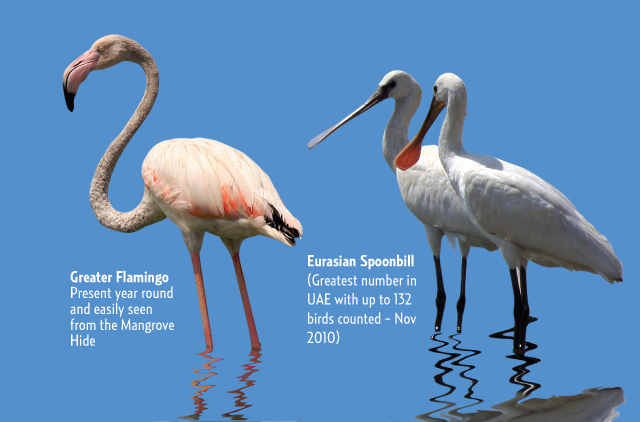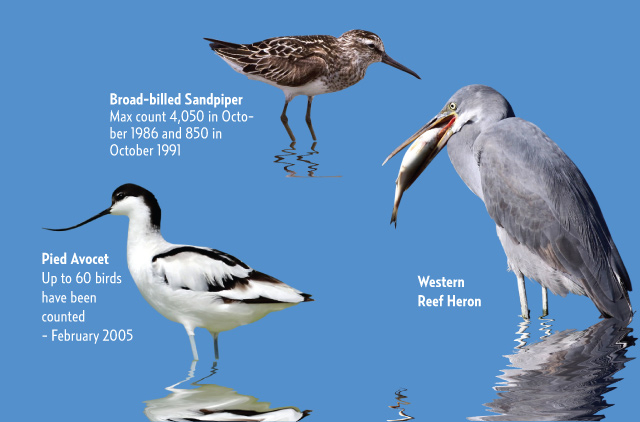
Dubai: Areas of spectacular biodiversity were celebrated on Wednesday on World Wetlands Day. Ras Al Khor Sanctuary is one of them.
In the 1980s, the unfenced, barren and mostly dry area was a desolate tract where less than 100 greater flamingos stopped before continuing their migration.
In pictures: Ras Al Khor wilelife Sanctuary
The site's beginnings have the mallard duck to thank, after 3,000 were imported in 1985 to breathe life into the mudflat. They were homed at the tail-end of the tidal creek — what is now the body of the sanctuary — recalls Kevin Hyland, ecologist at the Wildlife Protection Office who arrived in the UAE in 1982.
The area, devoid of greenery, was managed by the authorities, he said.
"A water tanker came once a day to fill a trough of water for the ducks, they were fed by man and soon enough the flamingos caught on to this. That was how the first focus on the flamingos emerged," he said. "The area was completely devoid of vegetation but the causeway existed," he said, pointing beyond the Flamingo Hide on Oud Metha road. "That is the last remnants of the duck feeding station," he said.
Almost completely sunk in mud stand vertical structures that blend into the environment, seemingly not burdening the 2,700 greater flamingos that were recorded in 2010 — a record number for the site.
Today, birds wade in two distinct water systems in the wetland.
The first is the natural end of the creek. The second is closed off from the Arabian Gulf and has treated sewage water from the Al Awir treatment plant pumped in. "It's equal to brackish water in salinity, about a quarter of the strength of seawater," said Hyland. "This is what makes it a constructed wetland."
Success and failure
Recent figures were unavailable but in 1993, around 100,000 cubic metres of treated water were put in the manmade side of the wetland every day. Efforts to make the birds at home have included building nests and planting mangroves. In 1989 however the first mangrove seedlings didn't take root. The following year, military earth movers were brought in to level the ground which removed the nutrient-rich topsoil, but was instrumental in deciding that proper protection should be given to the area, said Hyland. Some ideas were successful and others failed, such as an island built in the creek to attract birds — unfortunately is disappeared at high-tide.
"The flamingos don't use it at all," said Hyland. The fence, put up in 2002, and bird hides in 2005 were a ‘massive landmark' towards achieving Ramsar status by creating a buffer for the reserve, he said. "It's a most extraordinary site. The low lying mudflats are important for ground-nesting birds and one man, Colin Richardson, almost put the spotlight on this place single-handedly," he said of one of the UAE's first bird recorders.
Another landmark moment was the placing of the oil boom to separate the sanctuary from the rest of the creek. "The boom created a natural barrier. Jet skiers couldn't tear up the creek, scattering all the birds anymore," he said. By 1994 around 45,000 mangrove seedlings had been successfully planted, but the introduced flora is staring to spread too far and will need to be controlled.
What is Ramsar?
February 2 is World Wetlands Day. It marks the date of the signing of the Convention on Wetlands in 1971 in the Iranian city of Ramsar. World Wetlands Day was celebrated for the first time in 1997. The UAE had acceded to the Convention on wetlands of global importance in 2007 under Federal Decree No. 11 of 2007.
The number of members of the Convention is currently 160 countries, and the list includes the 1912 Ramsar site that covers about 187 million hectares. The most recent site to join the Ramsar list is Wadi Wurayah in Fujairah which was listed this week.
The definition of "wetlands" refers not just to marshes and lakes, but also coral reefs, peat forests, temporary pools, even underground caves, and all sorts of other systems everywhere from the mountains to the sea, including manmade habitats.
While Dubai Municipality laid the groundwork for the accession of the UAE to the convention, Fujairah Municipality worked with the Emirates Wildlife Society-WWF to put the Wadi Wurayah on the map at the local and international levels. It covers 129 square kilometres and has environmental and scientific value due to its exceptional biodiversity and is home to 12 species of mammals, 73 species of birds, 17 species of reptiles and amphibians, one species of fish and 74 invertebrate families, of which 11 are species new to science.
Creation of Ras Al Khor Sanctuary: From past to present
1972
Early photos of the creek show the dry and barren landscape around the inland tidal creek. There is no fence, no roads and no houses.
1985
Mallard ducks are imported to inhabit the mudflat. Their feed attracts flamingoes. Remnants of duck feeding station still visible at Flamingo Hide.
1986
A small island is reclaimed in creek to attract flamingoes but not successful. Oil boom placed across the creek to demarcate the bird wading area from the water sports. Mangrove planting begins but seedlings fail.
1990
Military earth movers are brought in to flatten the area in preparation for more extensive mangrove plantations and inadvertently scrape nutrient rich mud-flat soil out of the way.
1991-94
Around 45,000 mangrove seedlings are planted over the next three years.
1993
The removed mudflat soil forms a mud barrier at the end of the creek. The other side is devoid of any water and decision to pump treated water from treatment plant is made, creating a constructed wetland as extension of tidal mudflats.
1996
Fibreglass flamingoes were placed around the reclaimed island to attract real birds. They are still there.
1999
Ras Al Khor is protected by local decree as a wildlife sanctuary.
2002
A fence is erected around the wetland, boosting conservation and keeping four-wheel drives, feral dogs, and other intrusions out. Talks of Ramsar certification begins.
2003
Dubai Municipality is officially made the management authority of the site and its jurisdiction is outlined.
2005
Bird hides are built to encourage the public to come and enjoy the area.
The UAE ratifies the Ramsar Convention and Ras Al Khor becomes a de facto Ramsar site.
2010
Around 2,700 flamingoes are recorded in November, the highest number so far.
























